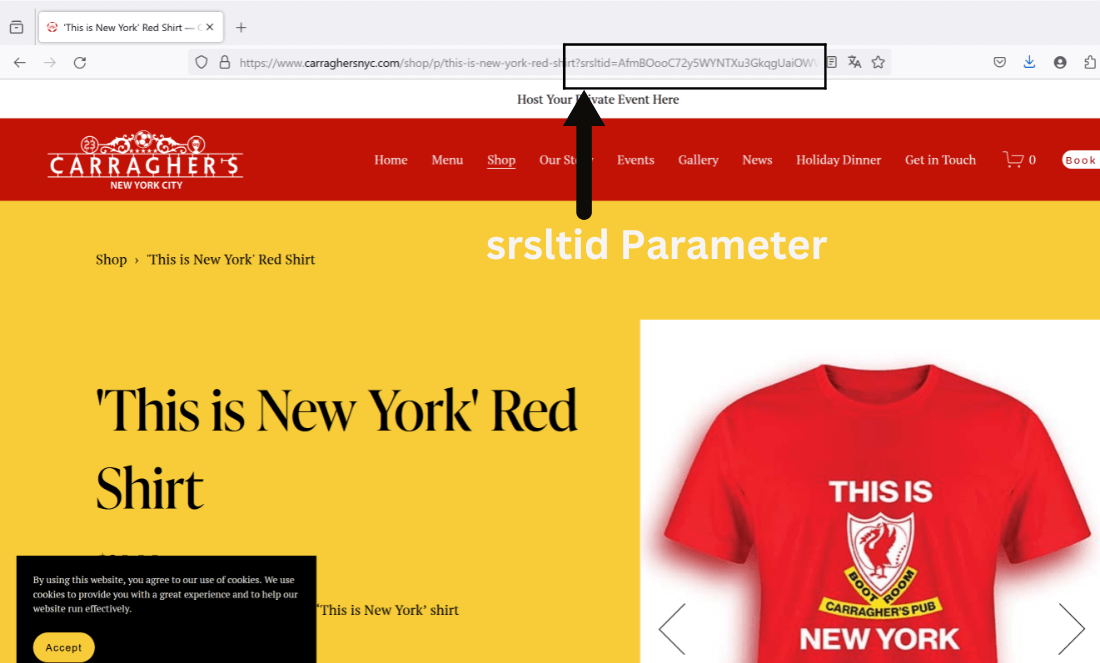Fact Check: Understanding the "srsltid" URL Parameter in Google Search Results

Hendrik

Debugging:
- Featured Image URL: https://seo-experiments.net/assets/people-with-laptops-in-front-of-the-google-logo-and-srsltid-written-on-it.webp
- Alt-Text:
Since early August, a growing number of webmasters and SEO specialists have observed the increasing prevalence of the srsltid parameter within Google search result URLs. This unexpected addition has left many website owners puzzled, sparking concerns about its potential effects on SEO performance and web analytics accuracy. In this comprehensive analysis, we explore the origins of the srsltid parameter, its intended purpose, and offer strategic guidance for website operators to navigate this development effectively.
Understanding the srsltid URL Parameter
The srsltid parameter, likely short for "search result listing ID," is a dynamic string appended by Google to URLs displayed via the Google Merchant Center within organic search results. An illustrative example of such a URL is:
www.example-shop.com/product?srsltid=abc123xyz
Importantly, this parameter is not manually inserted by website administrators; rather, it is automatically generated by Google. Its primary function is to facilitate the tracking of user interactions with product listings that appear organically through the Google Merchant Center.
Technical Insights into the srsltid Parameter
The srsltid parameter is engineered to be highly dynamic, uniquely generated for each user interaction within the search results. Below are key technical characteristics:
Complex Structure: The
srsltidtypically comprises a sophisticated mix of alphanumeric characters, for example, srsltid=ARCZmf0XB0Vg3QZ1CjDrQQcMmyxbhcuXYw.Real-Time Generation: Each instance of the parameter is created in real-time, corresponding to individual search sessions and user clicks.
Session-Specific Validity: The parameter remains valid only for the duration of the current browsing session. Subsequent visits to the same URL may not include the
srsltidparameter.

Origins of the srsltid Parameter
The srsltid parameter originates from the Google Merchant Center's auto-tagging feature. Initially designed to enhance tracking capabilities for paid shopping advertisements, this feature has now been extended to encompass organic product listings. This strategic expansion allows Google to provide merchants with more granular insights into the performance of their organic listings.
John Mueller, a renowned Search Advocate at Google, shed light on this development in a detailed LinkedIn post:
"I followed up on this with the team, and here’s roughly what’s happening.
These URL parameters are added for Merchant Center ‘auto-tagging’ (there’s more about it at Google Merchant Center Support), when a site-owner has activated that feature. They’re used for conversion tracking for merchants. We plan to update the help page as appropriate once this rolls out more.
They’re added in search directly, with unique IDs using the ‘srsltid’ parameter that you mentioned. The URLs are not indexed or crawled like that. It’s not a new setup; we’ve used this for quite some time, for example, in the shopping tab. We’ve now expanded it to traditional search results.
This doesn’t affect crawling, indexing, or ranking – it’s basically just for analytics for merchants. While not necessary, you can use the link rel=canonical element pointing at the preferred URL for indexing as you normally would. If you don’t want it, you can just turn off the setting (though it seems useful to me!). In Search Console, you mostly see the old usage of the parameter; we try to filter it out for the normal search results."
Read John Mueller’s LinkedIn Post
Key Takeaways from Mueller’s Statement
Activation through Merchant Center: The
srsltidparameter is appended only when auto-tagging is enabled in the Google Merchant Center.Enhanced Conversion Tracking: This parameter facilitates precise tracking of conversions related to product listings.
Non-Indexed and Non-Crawled URLs: URLs containing the
srsltidparameter are neither indexed by search engines nor crawled, ensuring they do not interfere with SEO.Neutral Impact on SEO: The introduction of the
srsltidparameter does not influence crawling, indexing, or search engine rankings.Optional Implementation: Website owners have the flexibility to disable this feature within the Merchant Center if it does not align with their tracking needs.
Implications for SEO and Web Analytics
While Google has assured that the srsltid parameter does not directly impact search rankings, its presence introduces several considerations for SEO and web analytics professionals:
Tracking Accuracy: SEO tools and rank tracking software may interpret URLs with and without the
srsltidparameter as distinct pages, potentially skewing analytics data and reporting accuracy.User Experience: The inclusion of lengthy and complex parameters in URLs can detract from user trust and potentially lead to confusion or decreased click-through rates.
Security Implications: Some security systems and firewalls may flag URLs with unfamiliar parameters as suspicious, possibly hindering legitimate traffic.
Caching Efficiency: Server configurations that cache content based on URL parameters might inadvertently cache multiple versions of the same page, affecting server performance and cache storage.
Strategic Recommendations for Website Owners
To mitigate potential drawbacks associated with the srsltid parameter, webmasters and SEO experts should adopt the following best practices:
Audit Google Merchant Center Settings: Verify that auto-tagging is appropriately configured within the Merchant Center. Disable auto-tagging if it does not align with your tracking objectives.
Implement Canonical Tags: Utilize canonical tags on all relevant pages to point to the preferred URL version without the
srsltidparameter. This helps consolidate link equity and prevent duplicate content issues.Optimize Web Analytics Configuration: Adjust settings in Google Analytics or other analytics platforms to recognize and filter out the
srsltidparameter. This ensures accurate data collection and prevents inflated pageview metrics.Monitor Search Engine Results Pages (SERPs): Regularly review how your URLs appear in search results to identify any negative trends or unexpected changes in visibility and ranking.
Evaluate Server Performance: Ensure that your server efficiently handles URLs with parameters, avoiding excessive caching variations that could degrade performance.
Leverage Enhanced Data Insights: If you continue using auto-tagging, capitalize on the rich tracking data provided by the
srsltidparameter to gain deeper insights into user behavior and conversion pathways.
Broader Impact on Online Marketing
The implications of the srsltid parameter extend beyond SEO, influencing various facets of online marketing:
E-Commerce and Conversion Optimization: The detailed tracking capabilities enable more precise analysis of conversion sources, aiding in the optimization of product listings and marketing strategies.
Content Marketing: Enhanced tracking provides valuable data on the performance of specific content pieces, informing content creation and distribution strategies.
Data Privacy Compliance: Website owners must ensure that the use of the
srsltidparameter adheres to data protection regulations such as the General Data Protection Regulation (GDPR), safeguarding user privacy and maintaining regulatory compliance.
Future Developments and Outlook
The emergence of the srsltid parameter signifies Google's ongoing efforts to integrate organic and paid search functionalities more seamlessly. By extending auto-tagging capabilities to organic listings, Google empowers merchants with enhanced analytical tools to measure and optimize their online presence. Looking ahead, it is anticipated that Google will continue to expand Merchant Center features into organic search results, potentially increasing the importance of structured data and further refining analytics for product listings.
Conclusion
The introduction of the srsltid parameter represents a noteworthy evolution for webmasters and SEO professionals. While it offers valuable insights for tracking organic product listings, it also necessitates careful management to ensure SEO integrity and accurate web analytics. By adhering to the recommended strategies, website owners can effectively navigate the complexities introduced by the srsltid parameter, minimizing potential drawbacks while harnessing its analytical benefits.
Ultimately, the deployment of the srsltid parameter underscores the dynamic and ever-evolving nature of the search engine ecosystem. To maintain and enhance their visibility and performance in search results, website owners and SEO experts must remain vigilant and adaptable, continuously refining their strategies in response to such developments.


